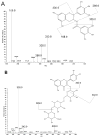A Possible Effect of Concentrated Oolong Tea Causing Transient Ischemic Attack-Like Symptoms
- PMID: 24900951
- PMCID: PMC4041283
- DOI: 10.9734/BJMMR/2013/4703
A Possible Effect of Concentrated Oolong Tea Causing Transient Ischemic Attack-Like Symptoms
Abstract
Aims: Tea (green, oolong, and black) is the second most widely consumed beverage worldwide, second only to water. Aside from a few reported adverse effects, tea, particularly green tea, appears to be beneficial for human health. In the case described herein, a male experienced several transient ischemic attack-like symptoms immediately following the consumption of a cup of high quality oolong tea. A thorough medical evaluation uncovered no evidence of such an attack and leads to the suggestion of a heretofore unreported response to oolong tea.
Presentation of case: A 72-year old male with hypertension and atrial fibrillation, who takes valsartan/hydrochlorothiazide to control hypertension and warfarin to reduce the risk of thrombosis and thromboembolism, presented at the emergency room of a local hospital describing several transient ischemic attack-like symptoms immediately after consuming a cup of oolong tea. His symptoms included presyncope, disequilibrium, bilateral hand parathesias, mild dysphasia, and visual problems (but apparently not presbyopia or amaurosis fugax), all of which had disappeared in approximately two hours after drinking the tea. (Mild presyncope was previously noted by the patient when ingesting a strong green tea.) No unusual features emerged from his physical examination, and his blood work was unremarkable except for elevation of his partial thromboplastin time (39 sec) and prothrombin time (22.5 sec), giving an international reference of 2.0, all consistent with the effects of warfarin. A battery of tests by the emergency room physician, a cardiologist, and a neurologist, e.g. electrocardiogram, brain computerized tomography, 2-dimensional transthoracic echocardiogram, brain magnetic resonance imaging, with and without 20 ml Gadolinium, and a magnetic resonance angiogram, confirmed the earlier diagnosis of atrial fibrillation but disclosed no additional malfunction in his heart. His brain showed no evidence of a prior hemorrhage, and his carotid arteries were clear.
Methodology and results: Analysis of the oolong tea by high performance liquid chromatography and mass spectrometry identified the major catechins and two methylxanthines, caffeine and theophylline, as well as other constituents, but there was no evidence of any extraneous chemicals that could lead to the symptoms.
Conclusion: In view of the rapid onset of symptoms after the consumption of oolong tea, bilateral as opposed to unilateral parathesis, and the absence of any evidence of a hemorrhage or the presence of impurities in the tea, we suggest that the transient ischemic attack-like symptoms could possibly be attributable to one or more components of the oolong tea and was not an atypical magnetic resonance imaging-negative transient ischemic attack.
Keywords: Transient ischemic attack; high performance liquid chromatography; mass spectrometry; oolong tea.
Conflict of interest statement
Authors declare that they have no competing interests.
Figures


References
-
- Harbowy ME, Balentine DA. Tea chemistry. Crit Rev Plant Sci. 1997;16:415–480.
-
- Balentine DA, Wiseman SA, Bouwens LCM. The chemistry of tea flavonoids. Crit Rev Food Sci Nutr. 1997;37:693–704. - PubMed
-
- Higdon JV, Frei B. Tea catechins and polyphenols: Health effects, metabolism, and antioxidant functions. Crit Rev Food Sci Nutr. 2003;43:89–143. - PubMed
-
- Cabrera C, Artacho R, Gimenez R. Beneficial effects of green tea-A review. J Am Coll Nutr. 2006;25:79–99. - PubMed
-
- Hodgson JM, Croft KD. Tea flavonoids and cardiovascular health. Mol Aspects Med. 2010;31:SI 495–502. - PubMed
Grants and funding
LinkOut - more resources
Full Text Sources
Other Literature Sources
Research Materials
